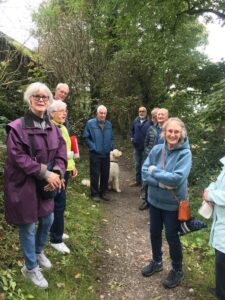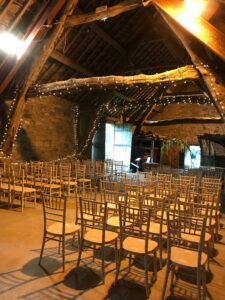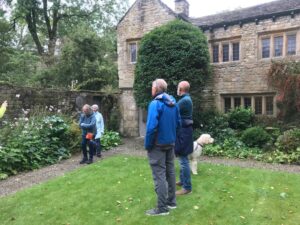Andrea Smith led us on a very enjoyable walk around upper Barrowford and we put a toe into Higherford too. Another nice dry autumn day with convivial and interested people.

Walk 9th October. By the riverside.
Attribution: GW
Of course the ford can still be clearly seen today next to the park and there were another few places where the river could be forded. The origins of the ‘Barrow’ part of the name remain hazy, without proof it can only be conjectured that a barrow existed here. We can however see solid evidence of the travel routes in these parts in the Toll House at the end of the bridge, this is situated on what was the Marsden to Gisburn to Long Preston turnpike. Earlier travellers would have used the packhorse bridge in Higherford, still in use for todays pedestrians. The Leeds and Liverpool canal close by was used to transport cotton made locally across to Liverpool and the coal that was transported was used to power the looms of Lancashire and beyond. The textile history of Lancashire is part of most people’s family history locally, not many families would not have had a relative connected to the cotton industry. Lancashire can hold its head high as a major powerhouse of the Industrial Revolution.

Walk Oct. ’21. Inside the Cruck Barn. Attribution:
GW
A fulling mill was recorded in Barrowford in the 16th century and until the late 18th century, the manufacture of woollen cloth was the primary industry, but in 1780 the fulling mill was rebuilt by Abraham Hargreaves as a cotton mill.
We visited the huge water wheel that powered Higherford mill and one man and his dog even commissioned a wedding ring in the Craft Workshop there. A water wheel was powered by water drawn off the weir at Pendle Water. The mill reservoir is now an ornamental pond in the park and nearby the children’s playground the remains of the mill can still be seen. Many handloom weavers cottages can be seen along the main road, production of woven cotton moved from here to massive weaving sheds after the introduction of power looms in the 1820’s.
Heavy reliance on the cotton trade for employment meant that this area would have been badly affected by the cotton famine during the American Civil War. The local history during that time will be the subject of our talk on November 9th by Steve Irwin.

Walk Oct. 9th ’21. Examining the vernaclar architecture of Park Hill.
Attribution:GW
Andrea pointed out many ‘hidden’ features that are actually in plain sight from the main road, including a converted barn by the side of the road and some lovely 17th century vernacular buildings. We finished by looking at the vernacular features of Park Hill and the very interesting Cruck Barn and it was gratifying to see the delight of people who had never visited the barn before. On the way down we saw the ‘leaky dams’ recently rebuilt by the gardener Peter. And we were just in time to catch the cafe for tea and cake!
Banner Image: Friends and guests overlooking the Pack Horse Bridge, Higherford.
Attribution: G Wray